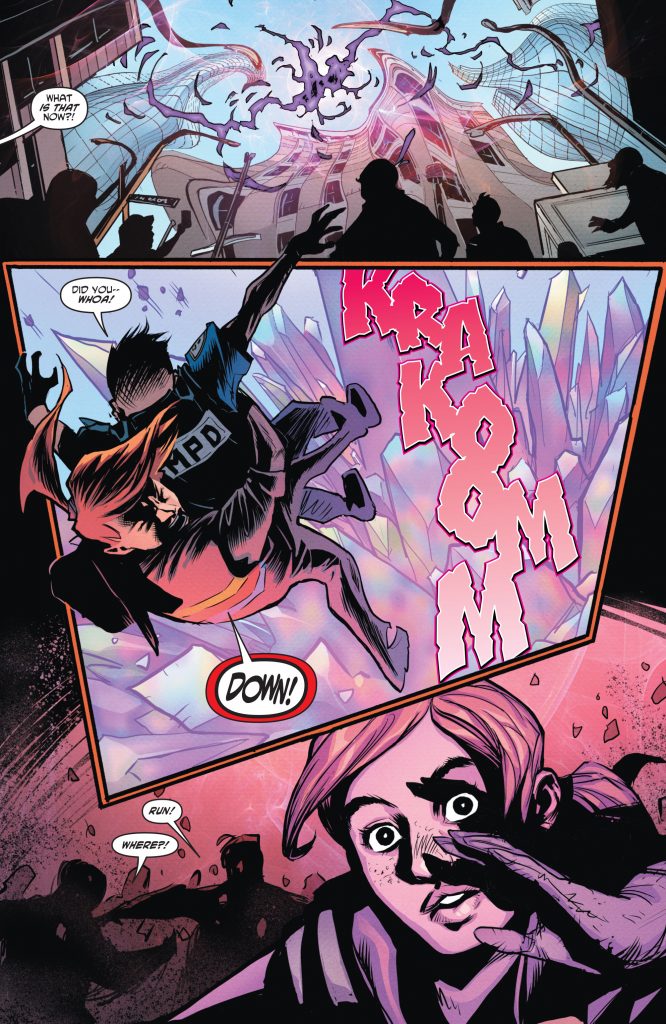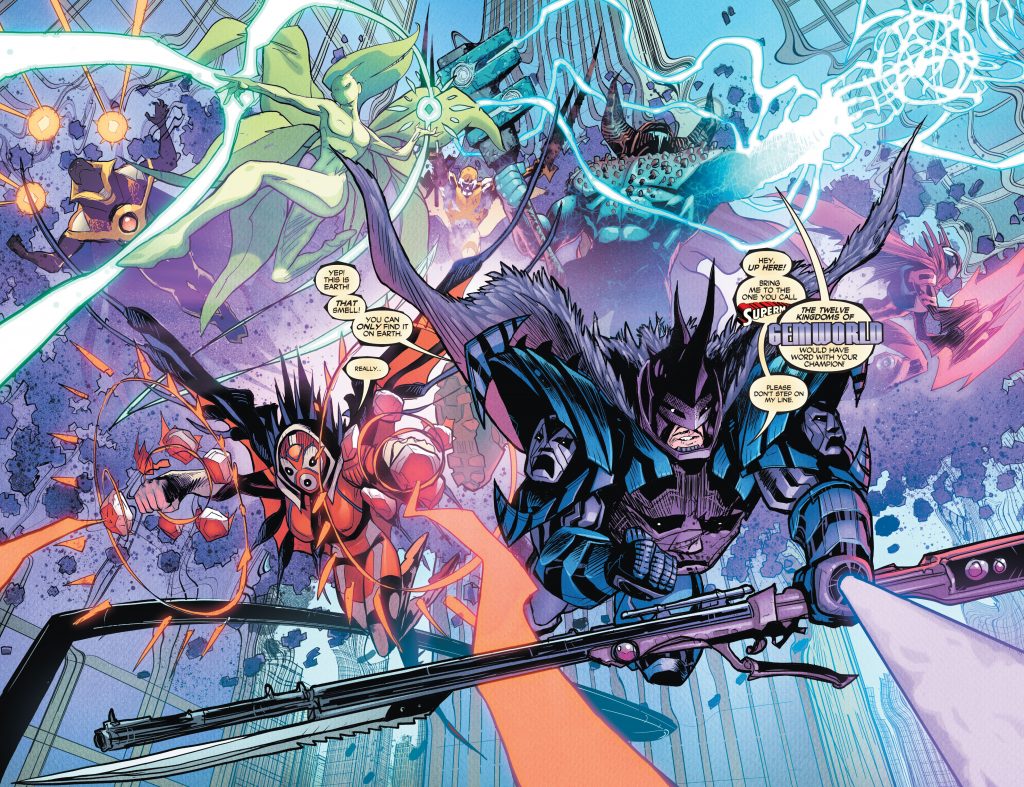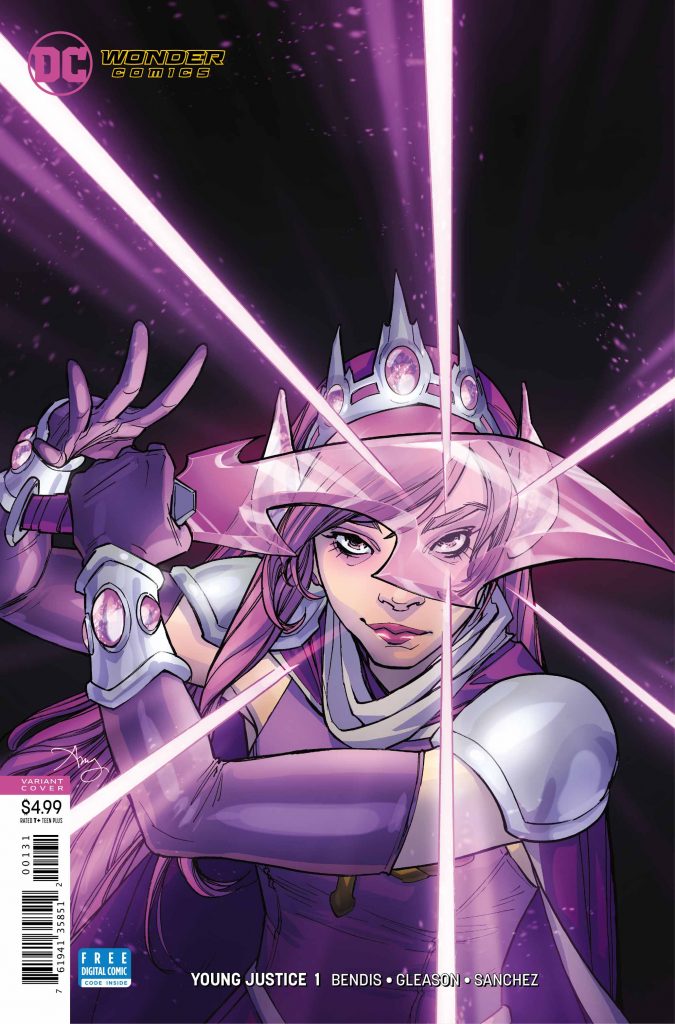THIS REVIEW OF ‘YOUNG JUSTICE’ CONTAINS MINOR SPOILERS.
by Brendan Hodgdon. We’re now about 7 months into the Bendis Era at DC, and creatively it seems things are going pretty smoothly so far. Bendis’ two-handed run with the Superman books has been well-received, and his personal Jinxworld imprint has continued to provide quality mature content. Now we kick off 2019 with the third pillar of Bendis’ DC domination in the form of the Wonder Comics imprint and its flagship title, Young Justice. While this debut issue might not carry quite as much depth as it could, it still has a great energy and style that makes it a fun and likable read.
Despite the marquee status that Bendis is afforded in this latest endeavor, it’s the work of Patrick Gleason and Alejandro Sánchez that really makes this book sing. Gleason displays a casual mastery of modern superhero storytelling, nailing everything that Bendis throws at him. Almost every character gets a big, splash-panel-y reveal shot, and the issue is filled with exciting bits of spectacle. The ongoing battle that runs through the whole issue is carefully balanced between capturing the chaos of a Gemworld invasion and keeping the action flowing for the reader. Gleason also handles the emotional beats very well, as his face work expresses backstory and relationships that the script only hints at. It’s a tour de force from an artist known for them. His work alone makes this issue worth a look.
Sánchez’s colors are fantastic; the bright and energetic vibe that he gives to the proceedings cements the fun tone. His work is just as effective in the few moments of alien menace at the beginning and end of the issue, and this flexibility blends with Bendis’ dialogue to keep this debut feeling lively and unpredictable. The art team operates in sync throughout, including the (dubiously-credited) lettering, which weaves Bendis’ traditional wordy dialogue through the battle scenes in a smart, focused fashion.
Bendis’ script does have that usual flair for dialogue, and provides some entertaining deconstructive beats with the villains, who maintain an effectively comedic tone throughout the main battle. The give-and-take amongst some of the characters is the right sort of relatable and naturalistic, which helps to ground everything. And there’s something to be said nowadays for a team book that actually has the entire roster present (and almost fully united) in the first issue. That last bit is largely accomplished thanks to the breakneck pace of the script, which packs in a bunch of characters and action beats. Unfortunately, it doesn’t leave a lot of room for the why of it all.
Some of this is due to a sort of mystery box element to the story; Bendis is clearly teasing some long-term story threads to be explored in future issues. And he does find time to nod at the history between the classic team members, most significantly in a conversation between Robin and Wonder Girl. But so much is left unsaid, or left to be filled in by metatextual knowledge of the characters’ shared histories, that there’s less in the way of firm character beats to latch onto. For longtime readers this might not present much of a roadblock, but it makes the issue feel a bit light in and of itself.
There’s also a weird dissonance in the way the new characters Jinny Hex and Teen Lantern are introduced into the story. Jinny is our entry point to the big battle, the (relatively) grounded character who gets swept up with the other heroes. We spend a good deal of time with her, and she seems to be the caretaker of one of the big mysteries that Bendis sets up. By issue’s end, we have a relatively clear understanding of who she is and what she’s about. Teen Lantern, on the other hand, not only lacks the same sort of distinctive splash-panel intro as the other heroes, but is not even seen in the issue itself. We only see her as a power ring construct obscuring her identity, which makes her feel less present in the story. It’s a weird detail, one that obfuscates what could otherwise be the most interesting character in the story.
One hopes that these gripes are only a by-product of the serialized structure, and that the whole story will make for a more balanced read come TPB time. Given the importance of bookstore sales, which concern Young Justice‘s target demographic, this might work out in the long run. In the meantime, while the story leaves a lot of stones unturned, it’s clear that Bendis’ dialogue and Gleason & Sánchez’s tremendous visuals are the main attraction. All told, Young Justice #1 certainly establishes the level of energy that the Wonder Comics imprint will doubtlessly have. It’s exactly the sort of fun, YA-friendly personality that mainstream comics should always provide.
Wonder Comics/DC/$3.99
Written by Brian Michael Bendis.
Art by Patrick Gleason.
Colors by Alejandro Sánchez.
Letters by DC Lettering.
7.5 out of 10
Check out this five-page preview of ‘Young Justice’ #1, including a six-variant cover gallery, courtesy of DC!
‘Young Justice’ #1 Variant Gallery:
Superboy variant by Jorge Jimenez.
Robin, Teen Lantern, Wonder Girl variant by Yasmine Putri.
Impulse variant by Derrick Chew.
Wonder Girl variant by Evan “Doc” Shaner.
Amethyst variant by Amy Reeder.
Black & White variant by Patrick Gleason

























